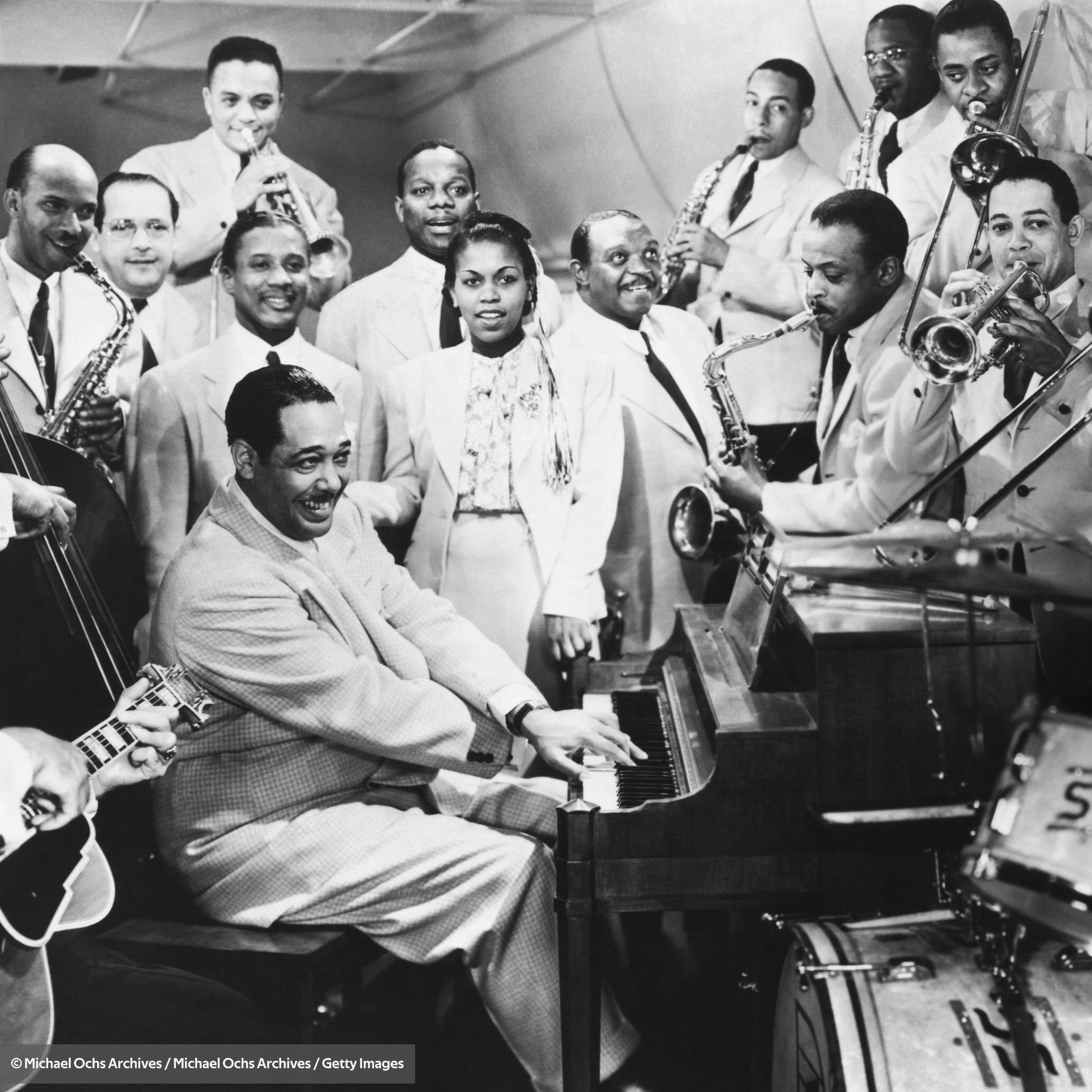7 The Big Band Era
Last time we compared and contrasted mainly Louis Armstrong and Bix Beiderbecke. Namely, this culminated into the Hot vs. Cool debate in jazz.
The Big Three
Going into the Big Bands, we'll start with Duke Ellington and His Orchestra. We'll then go to Benny Goodman and then Count Basie and His Orchestra. Now these bands are at least 10 instruments big, as they started to really be composing the modern Big Band idea that we know of today.
We start seeing a lot of jazz clubs in Harlem (and just generally downtown), most famously The Cotton Club.

Went to music school as a kid, immediately wanted to start a big band jazz band, and thus did so in Duke Ellington and His Orchestra. He could've been a classical composer so much that he could write in many different styles. There are 6 sets of books that are used that describe the styles of Duke Ellington:
- Impressionist Orchestral (think like impressionist painters)
- Romantic Ballads (ie: think of Mood Indigo)
- Exotic Pieces (ex: jungle music sound, all done to conjure up images to transport them to another place)
- Large Scale Suites (ex: more composed, less improvisation)
- The Big Swing Numbers (we all know these, like Take the A Train)
- Sacred Music (church music, or may be based on church texts)
Note that other bands like Benny Goodman's and Count Basie and His Orchestra's didn't really have this style.
Started in 1926, but played all the way into the 70's. Duke Ellington would bring his own style into his pieces.

Duke Ellington was the main composer. Some of the notable names in his band were:
- Bubbler Miley: Trumpet player in the 20s and 30s
- Cootie Williams: Trumpet player in the 40s
- Ben Webster: Tenor Sax player
Songs:
- East St. Louis Toodle-Oo (1927)
- You can hear this going away from the 1920s era of 4 Leaving Ragtime, Early Jazz
- You can hear Bubbler Miley on the trumpet, trying to get help from the rhythm section to create a "scary" sound.
- This song is so early (1927) that they still have banjo!
- You can hear the growling sound from the trumpet mute here!
- It's cool to see the reeds section of the Big Band with clarinets, which creates layers (the trumpets start layering too).
- Black and Tan Fantasy (1927)
- Creates a jungle feel
- Native drums, and the rhythm section is making it feel like a jungle
- The trumpet (again Bubbler Miley) uses the mute to recreate and add color of say jungle animals.
- Duke Ellington gets to do some Stride (Piano) in his solo.
- At the end we get funeral music (chopin), so he's quoting him (again, it's his style).
- Duke Ellington's Mood Indigo (1930):
- It's was said that he (along with the band) came up with this in 20 minutes right before the broadcast.
- There's smoother flow of the rhythm
- Notice the inclusion of the string bass now, keeping the rhythm and the walking tempo.
- He really liked inverting the roles of the upper/lower register instruments. Here the clarinet is playing low notes, the bones playing the high notes, and the trumpet is playing in the middle with a mute.
- A new one from (1952) is this arrangement
- Note the odd orchestration w/ bass clarinet and 2 muted bones.
- All these instruments perfectly played as a trio
- Again AABA Jazz Form.
- Concerto for Cootie (1940)
- Outline:
- 12 bar intro
- 1st Chorus: Trumpet + Sax
- 2nd Chorus: Sax + Cootie Williams
- 3rd Chorus: Bones/Clarinet
- Notice how much the sax + trumpet parts stays as the chorus, but they are always changing. Especially with Cootie Williams they start to comp for each other with Call And Response.
- Again the AABA form.
- You hear the Jungle style come back in.
- Here's it cool, not getting as high than in Jubilee.
- The bass is doing a Square Rhythm when it joins the saxes in the harmonic lines.
- Outline:
- Cottontail (1940):
- Features Tenor Sax player Ben Webster
- Form:
- AAB(4 measure interlude)
- Ben Webster solo
- Again Ben Webster solo
- Brass + piano
- Sax
- Brass + Sax
- Notice at the end they do the interlude at the very end (but just more modified)
- The bass and sax section get to do Call And Response.
- Notice that with 6 Into the Swing Era and onward, the Jazz Form becomes so important! Keep it in mind.
- Transbluency (1946)
- One of the first times we get to see a vocalist (almost sounds like a theramin
- Sounds very orchestral sounding and mysterious, especially in the form is a less swung style of jazz.
- Take the A Train (1941) (original)
- Has an AABA Jazz Form.
- Trumpet solo (played by Cootie Williams?)
- It’s cool cause the trumpet gets to Trading 4's with the whole rest of the band.
- The trumpet play loves to play the B sections with different scales that clog against the chord structures.
- See a more modern playing in 1962
- The Trading 4's part was on a different key to augment it.